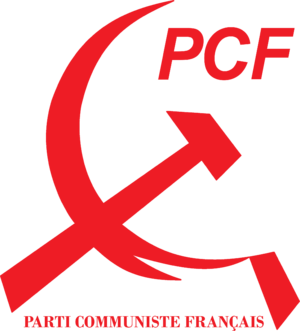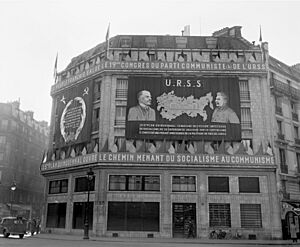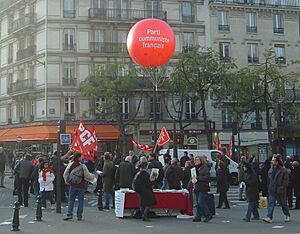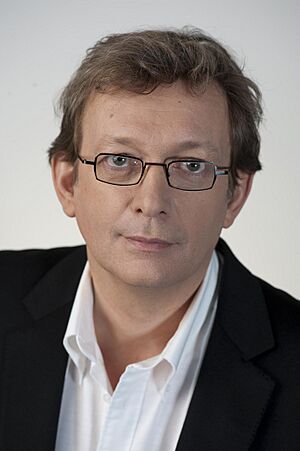History of the French Communist Party facts for kids
The French Communist Party (known as the PCF) has been a big part of French politics since 1920. It was strongest around the end of World War II. The party started when many members left another socialist group called the French Section of the Workers' International (SFIO). They formed a new party because they disagreed about World War I and whether to join the Communist International (Comintern).
The new party wanted to change society through revolution and had a strict way of making decisions called democratic centralism. Ludovic-Oscar Frossard was its first leader, and Ho Chi Minh, who later became famous in Vietnam, was also a founder. In the 1920s, the party faced many disagreements about working with other groups and following the Comintern's rules.
The PCF won seats in the French parliament and also supported worker strikes. They were against colonialism, which was when powerful countries controlled other lands. Leaders like Maurice Thorez (who led the party from 1930 to 1964) made the party follow a strict Stalinist path. This caused many members to leave, and the party lost some elections.
However, when Fascism grew stronger after 1934, the PCF changed its approach. It joined the Popular Front, a group of left-wing parties that came to power in 1936. The party helped France support the Second Spanish Republic during the Spanish Civil War and opposed the 1938 Munich Agreement with Hitler. During this time, the PCF also started to appear more patriotic and supported women having an important, but different, role in the communist movement.
Contents
How the Party Started
The French Communist Party began in December 1920. It was formed when a large group of members from the socialist French Section of the Workers' International (SFIO) decided to leave. These members wanted to join the Communist International (Comintern), which was set up in 1919 by Lenin after the Bolshevik Revolution in Russia.
Disagreements and New Ideas
Before this, in 1914, World War I caused arguments within the SFIO. Some members supported France's war efforts, but others were against the war. Over time, the anti-war groups became more influential. Also, the success of the Bolshevik Revolution in Russia made some SFIO members hope for a similar communist revolution in France.
After the war, joining the new Communist International became a big issue for the SFIO. In 1920, two leaders, Ludovic-Oscar Frossard and Marcel Cachin, went to Russia to meet with Bolshevik leaders. They saw the second meeting of the Communist International, where Vladimir Lenin explained 21 strict rules for joining. When they returned, Frossard and Cachin told the party to join.
The Big Split
At a meeting in Tours in December 1920, most SFIO members voted to join the Comintern. This group then formed a new party called the French Section of the Communist International (SFIC). They agreed to follow the strict rules.
However, most of the SFIO's elected officials and local leaders did not want to join. They disliked the Comintern's strict rules and its dislike of parliamentary politics. These members stayed in the SFIO, which became a smaller party but still had many elected officials.
The new communist party took over the party newspaper, L'Humanité, which had been started in 1904. The communists also formed their own trade union group in 1922. The SFIC saw itself as a revolutionary party, ready to use both legal and secret methods. It was run very strictly, with members having to follow the majority's decisions.
Ho Chi Minh, who later led Vietnam to independence, was one of the founding members of the PCF.
Difficult Times for the Party
In its early years, the new party struggled. It was weakened by many disagreements and members leaving or being kicked out. This happened as the Communist International tried to make all communist parties follow the same strict rules, a process called "bolshevization" or stalinization.
Changes in Leadership
The first leader of the PCF, Ludovic-Oscar Frossard, often didn't want to follow the Comintern's orders. He resigned in 1923 and left the party. Later, Pierre Sémard, a railroad worker, became the new leader. He tried to unite the party and form alliances with other left-wing groups. However, the Comintern criticized this idea. The party also spoke out against French colonialism in Morocco, which led to some members, including Sémard, being arrested.
In 1927, Josef Stalin took full control in the Soviet Union. He made the Comintern adopt a strict "class against class" policy. This meant that communist parties should see other socialist groups as enemies. In France, a group loyal to Stalin took over the PCF. They removed members who disagreed, and the party's membership dropped to less than 30,000.
Maurice Thorez became the new leader in 1930. The party continued its strict policies. The Great Depression, which hit France in 1931, caused a lot of worry. People looked for new solutions. Some PCF members, like Jacques Doriot, wanted to work with the SFIO. But Doriot was kicked out in 1934 and later formed a party that supported the Nazis during World War II.
The PCF also organized a counter-exhibition to the 1931 Colonial Exhibition in Paris. They called it "The Truth about the Colonies" to show the bad side of New Imperialism. Many artists and thinkers, like André Breton and Louis Aragon, joined the party in the 1920s.
The Popular Front Era
After far-right riots in 1934, the PCF and other socialist groups worried that France might become fascist. Adolf Hitler's rise to power in 1933 also made Moscow and Stalin change their strategy. They decided that communists should form "popular fronts" with other anti-fascist groups, even those they used to see as enemies. Maurice Thorez led the PCF to form an alliance with the SFIO and later the Radical Party, creating the Popular Front in 1936.
Growing Stronger
During the Popular Front years, the PCF grew quickly. It became very popular in working-class areas around Paris, known as the "Red Belt." The Popular Front won the 1936 elections, and the PCF gained many seats. Léon Blum, a socialist leader, formed a government that the PCF supported.
The PCF played a big role in helping the Spanish Second Republic during the Spanish Civil War. Even though Blum's government officially stayed neutral, it secretly helped send aid and weapons to the Spanish republicans. The PCF also sent French volunteers to fight in Spain.
The PCF was one of the few parties that opposed the Munich Accords in 1938. They believed this agreement would allow Hitler to focus on attacking the Soviet Union. The PCF also started to show itself as very patriotic. They encouraged young communist women to embrace marriage and motherhood, while still being active in politics.
World War II and Resistance
In August 1939, Germany and the Soviet Union signed a non-aggression pact. This shocked many French communists, and some left the party. When France entered World War II in September 1939, the PCF was banned by the government.
Before the Soviet Union Was Attacked
At first, the PCF said it would defend France. But then the Comintern told French communists that the war was "imperialist," meaning it was just about powerful countries fighting each other. So, the party changed its mind. PCF members in parliament called for peace. The party leadership fled abroad, and Maurice Thorez left the army and went to Moscow. The PCF became a secret organization.
After Germany invaded France in 1940, the PCF tried to get the Germans to allow their newspaper, L'Humanité, to be published again. These talks failed. The PCF avoided openly attacking the Germans at first, focusing instead on criticizing Britain and the French government that worked with the Nazis.
However, many communists secretly started organizing against the Germans and the French government that worked with them. They held a large protest in Paris in November 1940. In May 1941, the PCF helped organize a strike of over 100,000 miners. The French police and Germans began arresting many communists.
Fighting Back
When Germany invaded the Soviet Union in June 1941, Stalin ordered all communists to fight against the Nazis. The PCF increased its Resistance efforts in France. They started using direct action and assassinations. In August 1941, a communist named Pierre Georges killed a German naval officer. In response, the Germans executed 22 communists, including 17-year-old Guy Môquet, who became a hero.
By late 1941, the PCF created its armed group called the Francs-Tireurs et Partisans (FTP). They also began talking with Charles de Gaulle, the leader of Free France in London. The communists worked with the Free French but kept some distance from other resistance groups. In May 1943, the PCF joined the National Council of the Resistance (CNR).
By 1944, the PCF was very powerful in many parts of France because of its Resistance units. Some members wanted to start a revolution as the Germans left, but the leadership, following Stalin's orders, decided to work with the Allied powers and form a new Popular Front government. Many famous people, like Pablo Picasso, joined the party during the war.
After the War: Peak and Decline
After France was freed from German occupation in 1944, the PCF was very strong and respected because of its role in the Resistance. It was even called "the party of the 75,000 executed people."
Strongest Years
By the end of 1945, the party had half a million members, a huge increase. In the first elections after the war in October 1945, the PCF became the largest party in France, winning 26.2% of the votes. In November 1946, it achieved its best result ever, with 28.3% of the votes and 182 seats in parliament.
From 1944 to 1947, the PCF was part of the government. Maurice Thorez served as a minister. The PCF worked with the socialists and Christian democrats to introduce many social reforms. These reforms laid the groundwork for France's welfare state, including the nationalization (government taking control) of important industries like electricity and banks. They also set a minimum wage.
However, other countries, especially the United States, worried about the communists' power in France. In May 1947, the PCF was removed from the government. This happened around the same time the Italian Communist Party was also removed from Italy's government. The PCF reacted by organizing strikes.
Years of Isolation
After 1947, the PCF became isolated from other parties. It focused on its trade union activities, controlling the powerful General Confederation of Labour (CGT). Moscow also told the PCF to take a more radical approach. The PCF criticized the government as being controlled by American capitalism.
Strikes broke out in late 1947, with up to 3 million workers joining. But the strikes ended after some violent incidents, which made many people uneasy. From then on, the PCF remained in opposition, a large but less effective force in French politics.
Maurice Thorez remained the leader until his death in 1964, but he was often ill. The party stayed loyal to Stalin, even after his death in 1953. The PCF supported the Soviet invasion of Hungary in 1956, which caused some members to leave. The party lost seats in elections in 1951 and 1956, but it remained a major parliamentary force.
The Fifth Republic and New Alliances
In 1958, the PCF was the only major party that opposed Charles de Gaulle's return to power and the creation of the French Fifth Republic. They saw de Gaulle as a right-wing leader with too much power. Because of this, the PCF became even more isolated. In the 1958 elections, the PCF won only 10 seats.
Finding New Friends
However, over time, the PCF slowly started to reconnect with other left-wing parties. As political discussions shifted from the Algerian War to economic issues, the PCF gained back some supporters. In the 1962 elections, the PCF won more votes and 41 seats, helped by agreements with other left-wing parties.
In 1964, Waldeck Rochet became the new leader. He wanted to form a left-wing alliance against de Gaulle. In the 1965 presidential election, the PCF supported François Mitterrand, a left-wing candidate who opposed de Gaulle. Mitterrand did well, and the PCF also gained more seats in the 1967 elections.
May 1968 and Its Impact
In May 68, there were huge student protests and strikes across France. The PCF supported the general strike but was against the student movement, which was led by more radical groups. The PCF worried about losing control. They eventually supported agreements to end the strikes.
However, the PCF and the left suffered big losses in the 1968 elections. The PCF won only 34 seats. In terms of foreign policy, the PCF slowly started to distance itself from the Soviet Union. They were surprised and disapproved of the Soviet invasion of Czechoslovakia in 1968, which was the first time they publicly criticized a Soviet action.
In 1969, Jacques Duclos was the PCF's candidate for president. He did surprisingly well, coming in third place.
Working with Socialists and Decline
In 1972, Georges Marchais became the new leader. He started to make the party's policies more open. The PCF formed an alliance with Mitterrand's new Socialist Party (PS). They signed a "Common Programme" for the 1973 elections. This program showed the PCF's acceptance of democratic principles. The PCF hoped to gain more power than the PS, but instead, the PS grew stronger.
In the 1974 presidential election, the PCF supported Mitterrand, but some leaders secretly hoped he would lose. They thought he was too anti-communist. The left won many local elections in the mid-1970s, but the PCF's support slowly declined. In 1976, the PS got more votes than the PCF for the first time since 1936.
The PCF also tried to respond to growing criticism of Soviet communism. In 1976, they removed references to the "dictatorship of the proletariat" from their goals and said they supported democratic freedoms. However, they remained largely loyal to Moscow, even supporting the Soviet invasion of Afghanistan in 1979.
The alliance with the PS ended in disagreement. In the 1978 elections, the PS became the largest party on the left, surpassing the PCF. Marchais ran for president in 1981, hoping to regain leadership of the left. But it was a disaster for the PCF. Marchais won only 15.4% of the vote, and Mitterrand won the presidency.
Further Challenges and New Directions
The 1981 elections were a big blow for the PCF. Many of its supporters switched to the Socialist Party. The PCF won only 44 seats, while the PS won 285.
In and Out of Government
After the elections, the PCF joined Pierre Mauroy's government, their first time in power since 1947. Four communist ministers held positions. However, as the government changed its economic policies towards more austerity, the PCF's influence decreased.
The party suffered more losses in local and European elections in the early 1980s. In the 1984 European elections, the PCF won only 11.2%, and the far-right National Front gained similar support. In July 1984, the PCF resigned from the government and returned to opposition.
The PCF's support continued to fall. In the 1986 elections, they won only 9.8% of the vote. Georges Marchais refused to change direction, and the PCF remained loyal to Moscow until the Soviet Union fell in 1991.
Trying to Change
The fall of the Soviet Union caused a crisis for the PCF. But unlike some other communist parties, it did not dissolve or change its name. In 1994, Marchais stepped down, and Robert Hue became the new leader.
Hue tried to reform the party. He criticized the Soviet Union's rejection of individual rights and liberal democracy. The party changed its structure and moved away from strict Marxist-Leninist ideas. They even allowed public criticism of the party's decisions. However, these changes did not stop the party's decline.
In the 1995 presidential election, Hue got 8.6% of the vote. Under Hue, the PCF also renewed its alliance with the Socialist Party, forming the "Plural Left" coalition. In the 1997 elections, the PCF saw a small recovery, winning 35 seats. They joined Lionel Jospin's government, with several PCF ministers.
Continued Struggles
The PCF's recovery was short-lived. The party faced internal conflicts, with some members opposing the reforms and working with the Socialists. In the 1999 European elections, the PCF won only 6.8%. In the 2002 presidential election, Hue won only 3.4%, falling below the 5% needed for campaign expenses to be reimbursed by the state. For the first time, the PCF candidate got fewer votes than some Trotskyist candidates.
In the 2002 legislative elections, the PCF won only 4.8% of the vote and 21 seats. Hue lost his own seat. He resigned as leader in 2001, and Marie-George Buffet took over.
Under Buffet, the PCF tried a new strategy. They moved away from the Socialist Party and tried to work more with social movements, trade unions, and other activists. They also became more critical of the European Union. In 2005, the PCF played a big role in the "NO" campaign against the proposed European Constitution, which was a success.
The PCF also supported protests against government policies, like the "First Employment Contract" in 2006, which was eventually scrapped. However, these new strategies did not lead to a major electoral recovery. In the 2007 presidential election, Buffet won only 1.93% of the vote.
In the 2007 legislative elections, the PCF won only 4.3% of the vote and 15 seats. This was below the 20-seat minimum needed to form its own group in parliament. So, the PCF had to team up with The Greens and other left-wing MPs to form a parliamentary group.
The Left Front and Beyond
To try and stop its decline, the PCF sought to build a larger alliance with other smaller left-wing parties. In 2008, the PCF called for a "civic and progressive front." The Left Party, led by Jean-Luc Mélenchon, and other small groups responded positively. They formed the Left Front (FG) for the 2009 European Parliament election.
Working Together
The Left Front became a permanent alliance for several elections. This alliance helped the PCF stop its decline. The FG won 6.5% in the 2009 European elections and 8.9% in the 2011 local elections. However, this alliance also caused some tension within the PCF.
In 2010, Pierre Laurent became the new leader of the PCF. The PCF also played a big role in protests against a pension reform that raised the retirement age.
In 2011, PCF members voted to support Mélenchon as the Left Front's candidate for the 2012 presidential election. Mélenchon won 11.1% of the vote. In the 2012 legislative elections, the Left Front won 6.9% of the vote. However, the PCF itself won only 7 seats, its lowest number ever.
Despite this, the PCF leadership continued to support the Left Front strategy. In 2013, the hammer and sickle symbol was removed from party membership cards. Pierre Laurent explained that it no longer showed what the party was about today.
In the 2014 European elections, the Left Front kept a similar number of votes but lost two seats, both held by PCF candidates. In the 2015 regional elections, the Left Front and PCF together won just over 4% of the vote, which was a low point.
In 2016, Mélenchon created a new party, La France Insoumise. This caused a split, and the Left Front alliance effectively ended.
New Alliances and Recent Results
Since 2017, the PCF has run its own campaigns at the national level, with very low results. For example, in the 2019 European Parliament election, the PCF had its worst result since the 1920s. However, at the regional level, the party again formed joint lists with the Socialist Party.
In the 2022 French presidential election, the PCF's candidate, Fabien Roussel, won only 2.28% of the vote. For the 2022 French legislative election, the party joined a new alliance called the NUPES with other left-leaning parties. The PCF won 12 seats, which was two more than in the previous election.
Images for kids











